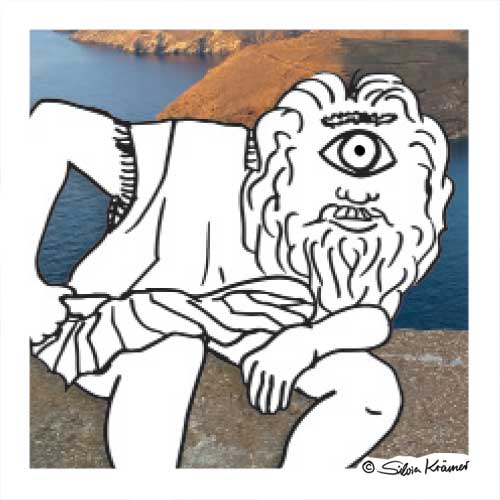In Greek mythology, Serifos is famous for two heroes:
Perseus beheading the Medusa and Odysseus (Ulysses) fighting the Cyclops.
FROM BEAUTY TO BEAST
The Medusa, in Greek mythology, was known as a gorgon with snakes for hair.
The Medusa's gaze would turn onlookers to stone. Originally a beautiful maiden and priestess
of the godess Athena, she was seduced by Poseidon in Athena's temple, an act considered sacrilegious.
Athena punished Medusa and transformed her into a monster with snakes for hair and
the ability to turn anyone who looked at her into stone.
FAMILY AFFAIRS
Perseus, born to Zeus and Danae, was feared by his grandfather, King Acrisius (king of Argos),
who had an oracle's prophecy foretelling his death by his grandson. Acrisius put his daughter and
her son in a wooden boat and left them drift in the Aegean Sea.
The boat reached Serifos and the fishermen Dictys, brother of the king Polydectes,
saved them and took them home.
After a few years the vicious Polydectes, fell in love with Danae and wanted to marry her.
To prevent the marriage, Perseus did a deal with Polydectes to save his mother.
Polydectes asked him to bring the head of the Medusa and he would Danae let go.
A MISSION IMPOSSIBLE...
... because the Medusa was notorious for one thing: whoever was staring at her would be petrified.
With many tricks and adventures, smart Perseus though found the Medusa.
He used a mirrored shield (given by Athena) to avoid Medusa's petrifying gaze and successfully beheaded her.
Perseus went back to Serifos and showed Polydectes Medusa’s head.
Polydiktis got petrified and his brother Dictys became the island’s king.
Many years later, the king Acrisius moved to the city of Larissa and attended at some funeral games,
in which his grandson participated - unbeknown to either of them.
During the games, a bad throw of Perseus' discus resulted in hitting Acrisius on the head,
causing his grandfather’s instant death... and thus fulfilling the prophecy of the oracle.
Perseus then, together with his wife Andromeda and his mother Danae, returned to Argos, where he became king.
According to ancient testimonies, the Serifians were worshiping Perseus and it is commonly
said that Chora resembles Medusa’s head.
Medusa's story is a complex one.
It is highlighting themes of beauty, punishment, and consequences of violating sacred spaces.
THE CYCLOPS
Serifos is also known as the island of the Cyclops Polyphemus.
On the journey home from the Trojan War, Odysseus (also: Ulysses) and his crew got on the shore at Serifos,
climbed up and found a cave. The cave was filled with food, wine and some sheep.
No one home.
The men went in the cave once more but all of a sudden Polyphemus, the one-eyed giant,
showed up and he got furious that the strangers were stealing his goods.
He imprisoned Odysseus and his men in the cave and he started eating them.
ODYSSEUS' ESCAPE PLAN
Odysseus got Polyphemus drunk and, when the cyclops asked his name, Odysseus replies "Nobody".
While Polyphemus slept, Odysseus and his men then blinded him with a sharpened wooden stake.
Polyphemus crying out in pain, told the other cyclopes that "Nobody" is attacking him.
They of course with this misunderstanding, assumed that Polyphemus is fine and didn't come to help him.
THE CAVE
According to legend, the cave of the cyclops Polyphemus is near the settlement of Mega Livadi.
THE THRONE - There is also a large ancient seat (or remains of a tower) known
as the 'Throne of Cyclops' or 'Psaropyrgos'.
It is located a few meters above the cave and believed to was a lookout for
the cyclops or a part of the cave complex.
THE ROCK - When Odysseus and his men sailed away, Polyphemus enraged and tried to stop them escaping.
So he threw a large rock towards their ship.
This rock is said to be Garbias islet, a small barren islet at Kalo Ambeli, not far from the cave.
